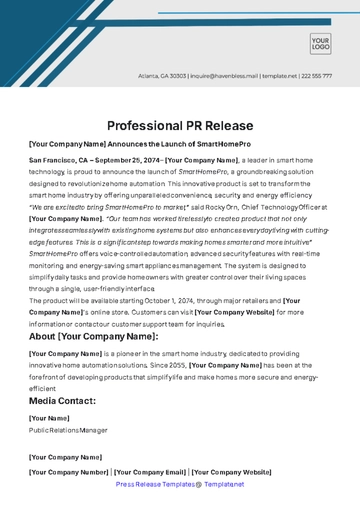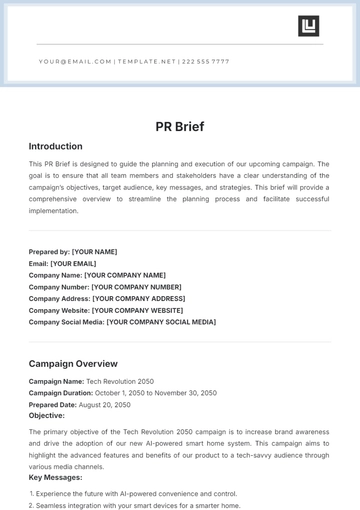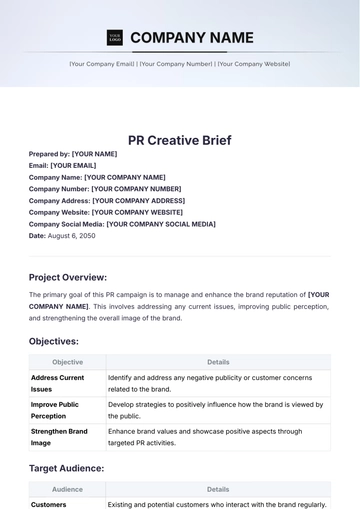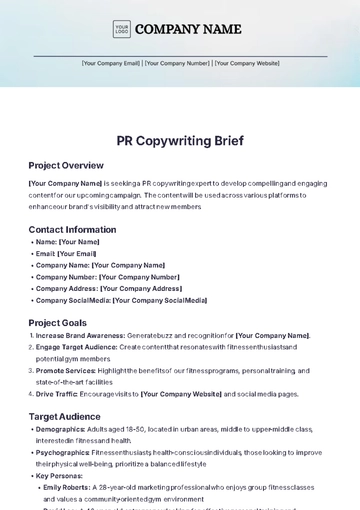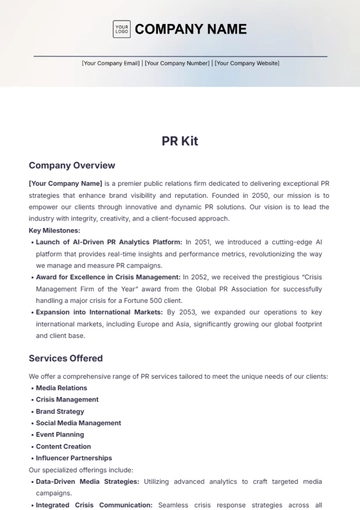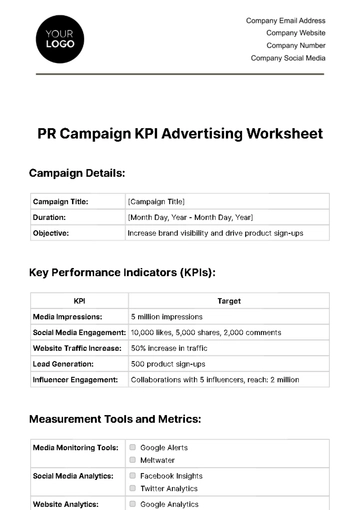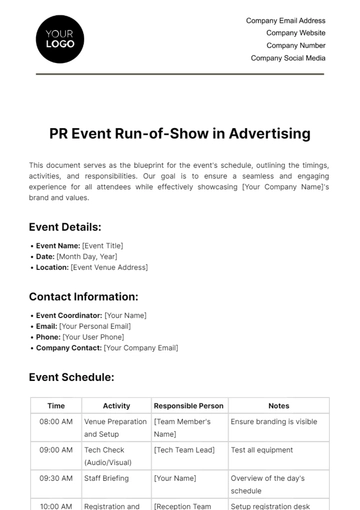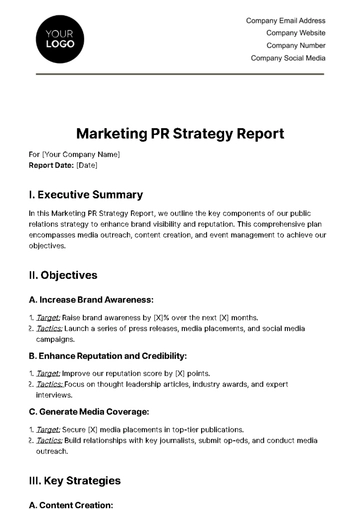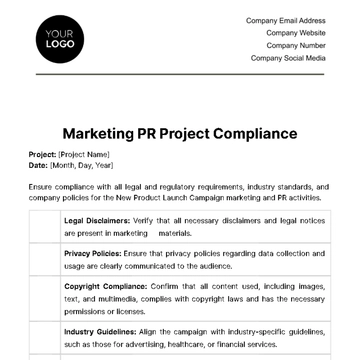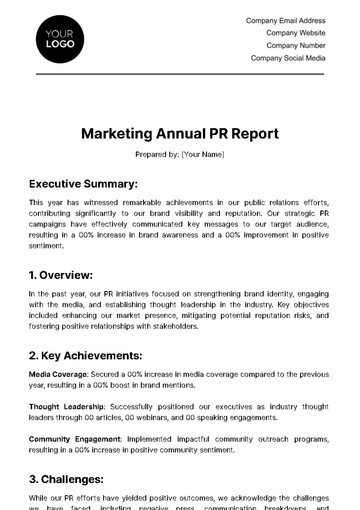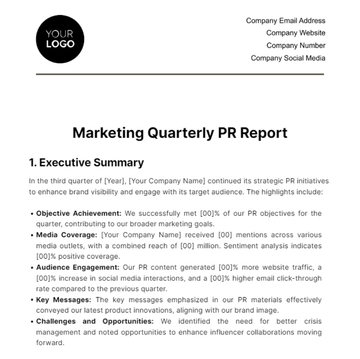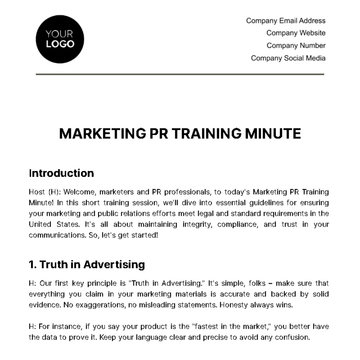Free Marketing Crisis PR Protocol
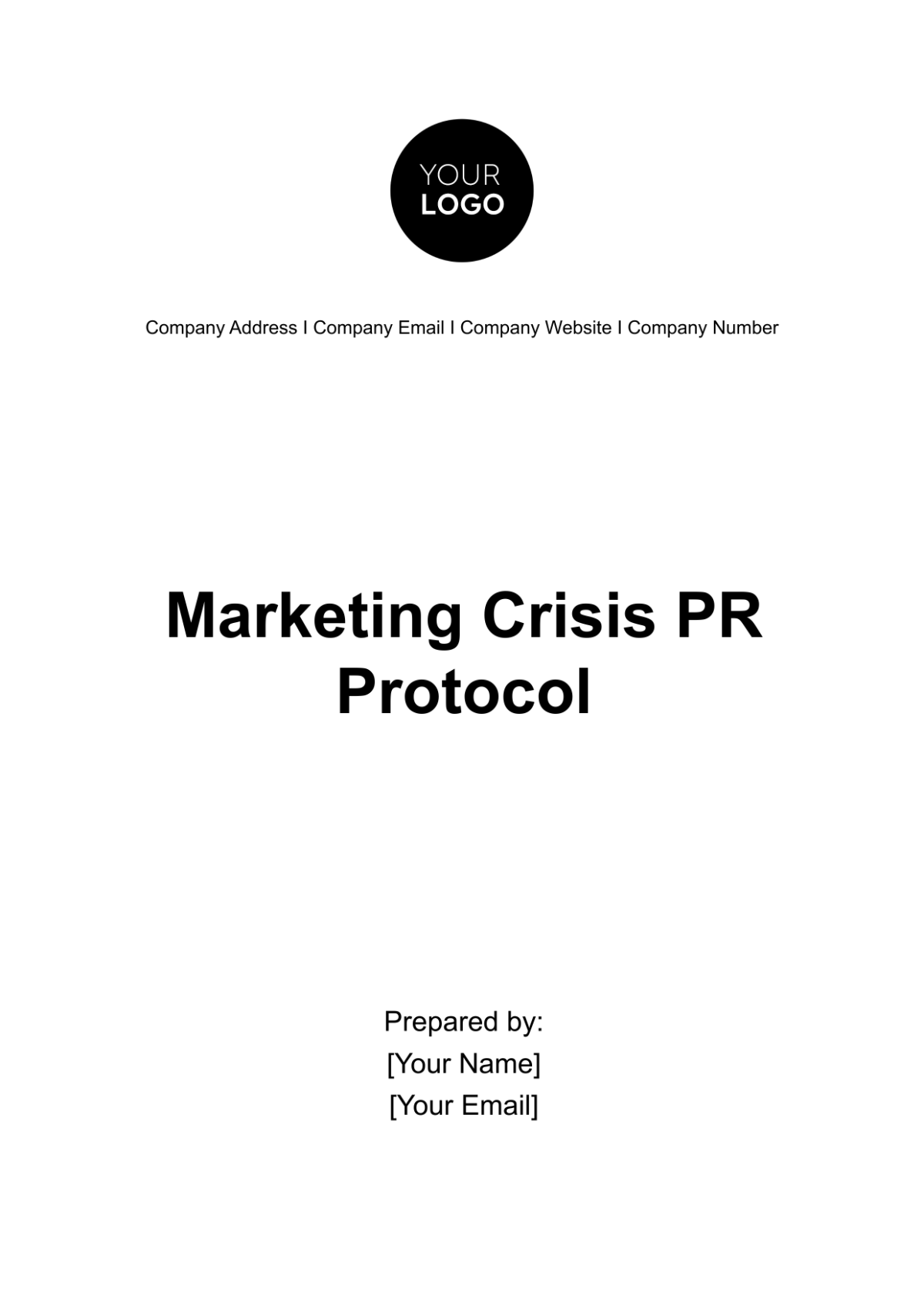
In today's dynamic business environment, companies are susceptible to facing crises that can threaten their reputation and market standing. The purpose of this Marketing Crisis PR Protocol is to establish a structured and comprehensive approach to effectively manage and mitigate potential crises. This protocol outlines the key steps and responsibilities for our Crisis Response Team to follow when addressing marketing-related crises.
1. Purpose of the Crisis PR Protocol
The primary purpose of this protocol is to:
Provide guidance to the Crisis Response Team for managing marketing-related crises.
Maintain transparency and trust with our customers, stakeholders, and the media.
Minimize reputational damage and financial impact.
Ensure a consistent and unified communication strategy.
2. Crisis Response Team
Our Crisis Response Team is a dedicated group of professionals tasked with swift and efficient crisis management. Each team member plays a critical role in safeguarding our brand reputation and ensuring transparent communication during challenging times.
2.1. Chief Marketing Officer (CMO)
As the leader of the Crisis Response Team, the CMO takes on the crucial responsibility of overall crisis coordination and strategy development. This role involves:
Assessing the severity and potential impact of the crisis.
Orchestrating a unified response across departments.
Approving crisis messaging and ensuring it aligns with our brand's values and mission.
Serving as the primary media spokesperson, conveying our message to the public and maintaining credibility and trust.
2.2. Director of Public Relations
The Director of Public Relations is instrumental in managing media relations and ensuring effective coordination within the team. This role includes:
Serving as the point of contact for all media inquiries and interactions.
Collaborating with the CMO to craft and distribute press releases, statements, and media materials.
Supporting the designated media spokesperson in interviews and media engagements.
Maintaining relationships with key media outlets and influencers.
2.3. Social Media Manager
In today's digital age, social media plays a pivotal role in crisis communication. The Social Media Manager takes charge of this vital aspect by:
Constantly monitoring our social media platforms for mentions, comments, and conversations related to the crisis.
Responding promptly to inquiries and comments, providing accurate information, and addressing concerns.
Crafting and disseminating crisis-related messages on our official social media channels.
Collaborating with the Director of Public Relations to ensure consistency in messaging across all communication channels.
2.4. Legal Counsel
Legal considerations are paramount during a crisis, and our Legal Counsel ensures that our actions align with legal requirements and mitigate risks. The responsibilities include:
Conducting a legal assessment of the crisis situation, identifying potential legal implications, and providing guidance on how to navigate them.
Reviewing and approving crisis messaging to ensure it complies with all relevant laws and regulations.
Collaborating with external legal experts as needed to protect our interests.
Advising on any legal actions that may be necessary during the crisis.
2.5 Customer Relations Manager
Our customers are a critical part of our business, and the Customer Relations Manager focuses on maintaining positive relationships and providing support during a crisis. This role encompasses:
Initiating timely and transparent communication with affected customers, addressing their concerns, and providing updates on the situation.
Gathering feedback from customers to understand their experiences and concerns, helping us make necessary improvements.
Collaborating with the Social Media Manager to address customer inquiries on social platforms.
Ensuring customer-facing teams are well-informed and trained to handle crisis-related interactions with care and empathy.
3. Identification and Assessment
In an era of rapid information dissemination, it is paramount that we remain vigilant and proactive in identifying potential crises. To this end, we maintain constant surveillance of various channels, including traditional media, social media platforms, and channels of customer feedback. We also utilize sophisticated monitoring tools to ensure that we are always on the lookout for emerging issues. In addition to vigilant monitoring, we have established a comprehensive set of criteria that guide us in identifying and classifying a situation as a crisis. These criteria help us differentiate between minor issues and events that have the potential to inflict significant harm on our brand and reputation.
3.1. Crisis Assessment
Once a potential crisis is identified, our Crisis Response Team swiftly mobilizes to assess the situation comprehensively. This assessment encompasses multiple dimensions:
Severity and Impact: We evaluate the severity of the crisis and its potential impact on our brand, stakeholders, and bottom line. This helps us prioritize our response and allocate resources effectively.
Legal Implications and Risks: Our legal counsel plays a crucial role in assessing the legal implications and potential risks associated with the crisis. They provide guidance on navigating any legal challenges that may arise during the crisis response.
Information Gathering: Thorough and accurate information is the cornerstone of an effective crisis response. We commit to gathering all available facts and data related to the crisis. This includes input from internal sources, external stakeholders, and independent experts if necessary.
4. Communication Strategy
4.1. Message Development
To effectively navigate a crisis, it is imperative that our messaging is not only clear and concise but also resonates with authenticity and empathy. Our messaging should encompass the following key elements:
Crisis Context: Articulate a precise understanding of the crisis, its origins, and the potential consequences it may have on our stakeholders.
Impact Assessment: Clearly communicate the impact of the crisis on our customers, employees, and partners. Acknowledge their concerns and demonstrate our commitment to addressing them.
Action Plan: Detail the concrete steps and strategies we are implementing to resolve the crisis. Highlight the measures taken to prevent a recurrence.
Brand Alignment: Ensure that our messaging remains aligned with our brand values and mission. Every word and action must reinforce our commitment to our core principles.
4.2. Internal Communication
Our employees are a critical part of our response to any crisis. Internal communication is not merely about disseminating information but also about rallying our team around a unified response. Here's how we should handle it:
Prompt Notification: Notify all employees of the crisis as soon as possible. Transparency is essential, and they should hear about it from us before they encounter it externally.
Role Clarity: Clearly define the roles and responsibilities of each employee in the context of the crisis. Ensure that everyone understands their contribution to the resolution effort.
Ongoing Updates: Maintain open and continuous lines of communication throughout the crisis. Regular updates help keep employees informed, engaged, and reassured.
Empathetic Support: Recognize the emotional impact a crisis can have on our team members. Provide resources for emotional support and encourage a culture of mutual assistance.
Feedback Mechanism: Establish a feedback channel where employees can share their observations, concerns, and suggestions. Act on this feedback to adapt our response as needed.
5. Media Relations
5.1. Media Response Team
To streamline and manage media interactions effectively, it is crucial to establish a competent Media Response Team:
5.1.1. Spokesperson Designation
Carefully select and designate spokespersons who possess excellent communication skills and a deep understanding of the crisis and our response strategy.
Ensure that the designated spokespeople are well-prepared and well-informed about the crisis and messaging.
5.1.2. Centralized Media Inquiry Handling
All media inquiries, including requests for interviews and information, should be channeled through the Director of Public Relations.
The Director of Public Relations will coordinate responses and ensure a consistent message is conveyed to the media.
5.2. Press Releases
In the digital age, press releases remain a cornerstone of crisis communication. They serve as a vital tool for keeping the public, stakeholders, and the media informed about the crisis and our response:
5.2.1. Content Creation
Expertly craft press releases that not only announce the crisis but also detail our strategic response and commitment to addressing the issue.
Include relevant background information to provide context for the crisis.
5.2.2. Timely Updates
Recognize that crisis situations evolve. Regularly update press releases with the latest information, developments, and actions taken.
Maintain transparency by clearly marking the date of each update to indicate the most current version.
5.2.3. Distribution Channels
Distribute press releases through a range of channels, including wire services, our company website, and social media platforms.
Ensure that press releases are accessible to the media, investors, and the general public.
5.2.4. Media Briefings
Consider organizing media briefings or conference calls to provide in-depth information to journalists and address their questions directly.
Coordinate media briefings in consultation with the Director of Public Relations to maintain consistency in messaging.
6.Social Media Management
6.1. Monitoring
Continuously monitor social media platforms for mentions of the crisis.
Identify influencers and key opinion leaders discussing the crisis.
6.2 Social Media Response
Respond promptly and transparently to comments and messages on our official social media accounts.
Avoid engaging in arguments or disputes.
7. Monitoring and Evaluation
7.1. Key Metrics
Effective monitoring and evaluation are pivotal in crisis management. The Crisis Response Team will meticulously track and analyze the following key metrics to gauge the extent and effectiveness of our crisis response:
Media Coverage: Monitor the volume and tone of media coverage to assess how the crisis is portrayed in the press.
Social Media Engagement: Analyze social media engagement metrics, including likes, shares, comments, and overall sentiment to gauge public perception and reactions.
Customer Sentiment: Utilize sentiment analysis tools to measure customer sentiment, collecting feedback from various sources to understand the evolving attitudes of our customer base.
Brand Reputation: Continuously evaluate changes in our brand reputation, comparing pre-crisis and post-crisis sentiment, trust, and perception.
Financial Performance: Assess any direct financial impact resulting from the crisis, such as sales, revenue, and stock performance.
7.2. After-Action Review
Post-crisis analysis is a vital step in our crisis management strategy. The Crisis Response Team will conduct a comprehensive after-action review to derive valuable insights from the crisis management experience. This review aims to:
Identify Lessons Learned: Scrutinize the crisis response process to pinpoint what worked well and what could be improved. Identify specific actions, decisions, or communications that were particularly effective or problematic.
Areas for Improvement: Highlight areas where the response could have been more efficient, transparent, or aligned with our brand values. Assess the effectiveness of the Crisis PR Protocol in guiding the response.
Communication Effectiveness: Evaluate the effectiveness of the crisis communication strategy, identifying any shortcomings or missed opportunities.
Internal Coordination: Review the coordination and cooperation within the Crisis Response Team and with other relevant departments, assessing if roles and responsibilities were clear and executed effectively.
Legal and Compliance Issues: Assess any legal and compliance issues that arose during the crisis response and identify areas for improvement in legal counsel's involvement.
Stakeholder Feedback: Gather feedback from key stakeholders, including employees, customers, and partners, to understand their perspectives and concerns during the crisis.
Crisis Protocol Updates: Based on the findings of the after-action review, update the Crisis PR Protocol as necessary. Ensure that the protocol reflects the lessons learned and incorporates improvements to enhance our crisis management capabilities.
In the face of a marketing-related crisis, it is essential to have a well-defined Crisis PR Protocol in place. This protocol outlines the roles and responsibilities of our Crisis Response Team, ensures a consistent communication strategy, and aims to protect our reputation and business interests. By following this protocol, we will be better prepared to address and manage marketing crises effectively.
- 100% Customizable, free editor
- Access 1 Million+ Templates, photo’s & graphics
- Download or share as a template
- Click and replace photos, graphics, text, backgrounds
- Resize, crop, AI write & more
- Access advanced editor
Navigate through crises seamlessly with the Marketing Crisis PR Protocol Template from Template.net. This editable and customizable resource empowers you to shape strategic responses. Tailor every aspect effortlessly with our Ai Editor Tool, ensuring a personalized crisis management plan that reflects your brand's resilience and professionalism. Face challenges with confidence!
